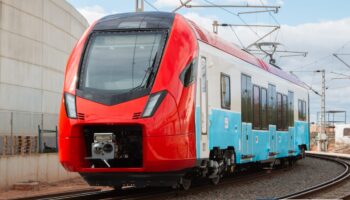Russia: So said Transport Minister Vitaly Savelyev on 15 February at a meeting on the development of the Moscow–Saint Petersburg high-speed railway (HSR). The meeting, held at Ural Locomotives, part of Sinara Transport Machines, was hosted by Russian President Vladimir Putin, who announced “the start of the work in this priority area”.
According to Vitaly Savelyev, 28 trains worth RUB 148 bln ($1.6 bln) will be bought in the first phase of HSR construction. Each car of an eight-car train will cost RUB 660 mln ($7,1 mln). “We envisage the building of a 100% Russian-made train at the production facilities of leading Russian transport engineering companies, Sinara Group and TMH”, he said. According to Interfax, after the meeting, the Transport Ministry head stressed that Sinara Group would assemble high-speed trains while TMH would provide support in the rolling stock production.
The design speed of the trains for HSR will be 360 km/h. Today, only China is developing trains for higher speeds. The HSR trains are planned to be highly automated with the GoA3 systems. As Vitaly Savelyev noted, the plan is to create vehicles that are independent of imported technologies. This will give a big boost to technological self-sufficiency and create new competencies in the Russian railway industry.
According to Vitaly Savelyev, the creation of a prototype train and the start of its certification tests are planned for 2026, and the delivery of the first batch of 28 vehicles for 2028. These deadlines are realistic if the concession agreement is signed by the end of April. The Minister of Transport asked Vladimir Putin to facilitate the conclusion of the agreement in order to ensure that the procedure for signing the contract for the supply of rolling stock is initiated and that the modernisation of production facilities is started.
The concession would cover the St. Petersburg–Zelenograd section, which is the largest part of the HSR project. The construction of the Moscow exits of the HSR will be financed by the investment programme of Russian Railways. The project budget of more than RUB 2 trn ($21.6 bln) provides for the use of various sources of financing: contributions to authorised capital of the concessionaire, bonds issued by the Gazfond pension fund, loans from Sberbank, VTB and Gazprombank. The state will support the project with funds from the National Wealth Fund to be returned by 2050, grants, and subsidies. After the meeting, Dmitry Peskov, the Russian President’s press secretary, said that although the framework of the project had been agreed, some details of the project’s financial model still needed to be worked out.
At the Ural Locomotives meeting, it was announced that the Moscow–St. Petersburg HSR project will require the purchase of a total of 44 trains, while the other already approved HSR projects — Moscow–Yekaterinburg, Moscow–Adler and Moscow–Minsk — will require more than 250 trains.















